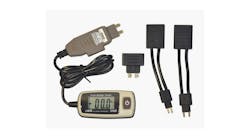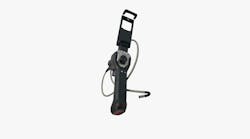Checking for power at panel mounted fuses and relays sounds like a straight forward proposition, right? Not in today's high tech power panels! What follows is some of the information you need to be aware of when playing the find the power game on modern vehicles.
In addition to checking if a fuse is blown or missing, you now have the added complication of determining the correct two holes of a three-hole fuse socket. Both GM and Chrysler now build fuse panel sockets with a choice of three sockets instead of the traditional two. Shown in Figure 1, you can see that using the sockets on the left and middle will power the load by an ignition switch feed. Using the the middle and the right sockets will power the load using a constant battery feed.
Mix up these positions and you may have a parasitic drain condition on your hands in one direction or a component not powered up when it should be on the other.
General Motors vehicles also play musical sockets with their fuses. In addition, GM provides relay sockets that can have two different mounting orientations in the same designated area. The 2006 Chevrolet Cobalt fuel pump relay shown in Figure 2 can be installed one row up in orientation by accident causing a no start condition. The service information diagram does not depict this potential difficulty very well.
Chrysler likes to hide its fuses in fancy costumes lately. I don't know why. Why do people dress up their cats and dogs? Looking at Figure 3, you can see the two yellow fuse holders and one black fuse holder. These holders have fuses underneath them and must be opened or pulled up in order to check the fuse for being blown. Both options require more finessing than standard mounted fuses.
If your shop is getting into programming these days, you probably have been instructed by the programming software to pull the Ignition On Demand (IOD) fuse before you can continue. When you search the service information for your specific vehicle, there is no IOD fuse listed anywhere. This is actually fuse No. 51 in the underhood fuse panel and is hiding in the black fuse holder shown in Figure 3. This fuse always feeds DLC pin 16 on Chrysler products. Check your vehicle specific wiring diagram to identify this fuse.
GM has added a new wrinkle in mounting relays in its power panels. It mounts relays inside the panel itself. Worse yet, it is not readily apparent in the service information that these relays are internal. The wiring diagrams will list them similar to "Front Wiper PCB relays No. 1." When you look for this relay location on the fuse panel cover sticker or panel view in the service information you will not find it. That is because the PCB in the name designation stands for Printed Circuit Relay, which means that is made integral to the fuse panel. These internally mounted relays are inaccessible and not separately serviceable.
Many manufacturers lately have been mounting their body control modules either directly to a fuse panel or creating fully computerized fuse panels in order to save wiring and have better control of electrical load management. This presents new testing challenges.
The 2008 Chrysler Town & Country starter relay circuit is one example of this type of situation. This relay is mounted at the underhood fuse relay panel known as a Totally Integrated Power Module (TIPM).
The relay control coil power is applied by TIPM not as a traditional hard wired connection but as an electronically switched input commanded by the TIPMs integral ECU. The relays control coil ground is supplied by another electronically switched circuit within the PCM. Both the TIPM and the PCM must see the correct messages on the CAN data network before the relay will actuate. This means the Ignition Switch, which is also an ECU called a Wireless Control Module (WCM), must send a security system OK and start position messages on the CAN bus to the PCM and TIPM.
The TIPM can then power the starter relay control coil. The PCM must see the correct PRNDL input and can then supply ground to the starter relay control coil. All these communication requirements and functions are not explicit in the factory wiring diagrams.
Jim Garrido of "Have Scanner Will Travel" is an on-site mobile diagnostics expert for hire. Jim services independent repair shops in central North Carolina. He also teaches diagnostic classes regionally for CARQUEST Technical Institute.
.jpg?auto=format,compress&fit=max&q=45&w=250&width=250)



